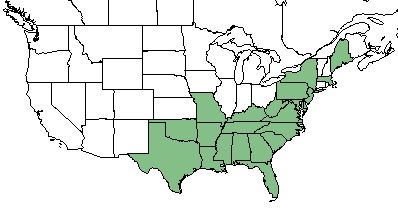Cyperus polystachyos
Common name: Manyspike Flatsedge [1], Coast Flatsedge [2]
| Cyperus polystachyos | |
|---|---|

| |
| Photo by the Atlas of Florida Plants Database | |
| Scientific classification | |
| Kingdom: | Plantae |
| Division: | Magnoliophyta - Flowering plants |
| Class: | Liliopsida - Moncots |
| Order: | Cyperales |
| Family: | Cyperaceae |
| Genus: | Cyperus |
| Species: | C. polystachyos |
| Binomial name | |
| Cyperus polystachyos Rottb. | |

| |
| Natural range of Cyperus polystachyos from USDA NRCS Plants Database. | |
Contents
Taxonomic Notes
Synonyms: C. polystachyos Rottbøll var. texensis (Torrey) Fernald; C. polystachyos Rottbøll var. paniculatus (Rottbøll) C.B. Clarke; C. microdontus Torrey; C. paniculatus Rottbøll; C. odoratus L.
Varieties: none
Description
C. polystachyos is an annual/perennial graminoid of the Cyperaceae family.[1] Leaves are simple and alternate, with linear shape and parallel leaf venation. Flowers are unisexual and bisexual, and developing fruit is an achene. Flowers are borne in a single dense cluster that have linear-ovately shaped spikelets, and 2 stamens. Fruit is dark to light brown in color and develops between summer and early fall. Roots are fibrous, and overall plant can reach a height between 1 and 3 feet.[3]
Distribution
C. polystachyos is pantropical can be found along the southeastern coast from Texas to Maine, Hawaii, the Pacific Belt, Puerto Rico, and the U.S. Virgin Islands.[1][2]
Ecology
Habitat
C. polystachyos proliferates in low fields, ditches and marshes, as well as warm temperate environments. [2] It is also present in sandy areas. [4] It is listed as a facultative wetland species, meaning it commonly can be found in wetlands but can also sometimes be found in non-wetlands.[1]
Phenology
C. polystachyos has been observed to flower between June and September.[5] It is also known to flower in October additionally.[2]
Fire ecology
C. polystachyos is not fire resistant, and has no fire tolerance.[1] However, it is commonly found in calcareous savannas that are fire dependent ecosystems.[6] A study also found seeds of C. polystachyos to persist in the seed bank after fire disturbance.[7]
Use by animals
This sedge is not known to have any foraging value.[8]
Conservation and Management
C. polystachyos is listed as endangered by the New Jersey Department of Environmental Protection and Energy Office of Natural Lands Management, and as extirpated by the Pennsylvania Department of Conservation and Natural Resources. [1]
Cultivation and restoration
Photo Gallery
References and notes
- ↑ 1.0 1.1 1.2 1.3 1.4 1.5 USDA Plant Database https://plants.usda.gov/core/profile?symbol=CYPO
- ↑ 2.0 2.1 2.2 2.3 Weakley, A. S. (2015). Flora of the Southern and Mid-Atlantic States. Chapel Hill, NC, University of North Carolina Herbarium.
- ↑ [[1]] Lady Bird Johnson Wildflower Center. Accessed: April 25, 2019
- ↑ URL: http://herbarium.bio.fsu.edu. Last accessed: June 2018. Collectors: Loran C. Anderson, R. Kral, Gil Nelson, R.K. Godfrey, Gwynn W. Ramsey, R.S. Mitchell, S.W. Leonard, Leo L. Minasian Jr., J. Sincock, William P. Adams, Paul O. Schallert, Grady W. Reinert, O. Lakela, A.F. Clewell, Cecil R. Slaughter, Richard D. Houk, Chas. C. Deam, Robert J. Lemaire, Sidney McDaniel, Jimmy Meeks, T. MacClendon, K. MacClendon, Richard Carter, John B. Nelson, Leah Garris, Frank Lee, R.A. Norris, Robert L. Lazor, Robt. Blaisdell, R.F. Christensen, William R. Stimson, S.M. Tracy, L.J. Brass, James D. Ray, Jackie Patman, Allen G. Shuey, Curtis R. Jackson, Jane Brockmann, Don Blake, George R. Cooley, Richard J. Eaton, Jean J. Wooten, Wm. G. Atwater, D.L. Martin, S.T. Cooper, J.P. Gillespie, H. Kurz, P.L. Redfearn Jr. States and counties: Wakulla County Florida, Franklin County Florida, Martin County Florida, Leon County Florida, Gadsden County Florida, Madison County Florida, Taylor County Florida, Escambia County Florida, Collier County Florida, Levy County Florida, Putnam County Florida, Sumter County Florida, Brevard County Florida, Glades County Florida, Seminole County Florida, Citrus County Florida, Manatee County Florida, Hillsborough County Florida, St. Johns County Florida, Polk County Florida, Lee County Florida, Santa Rosa County Florida, Charlotte County Florida, Indian River County Florida, Bay County Florida, Marion County Florida, Nassau County Florida, Osceola County Florida, Calhoun County Florida, Jefferson County Florida, Madison County Florida, Holmes County Florida, Gulf County Florida, Pinellas County Florida, Jackson County Florida, Richland County South Carolina, Lafayette County Florida, Glynn County Georgia, Palm Beach County Florida, Broward County Florida, Highlands County Florida, Walton County Florida, De Soto County Florida, Duval County, Hernando County Florida, Monroe County Florida, Suwannee County Florida, Pasco County Florida, Dade County Florida, Hamilton County Florida, Thomas County Georgia, Camden County Georgia, Clinch County Georgia, Decatur County Georgia, Lowndes County Georgia.
- ↑ Nelson, G. PanFlora: Plant data for the eastern United States with emphasis on the Southeastern Coastal Plains, Florida, and the Florida Panhandle. www.gilnelson.com/PanFlora/ Accessed: 18 MAY 2018
- ↑ Carr, S. C., et al. (2010). "A Vegetation Classification of Fire-Dependent Pinelands of Florida." Castanea 75(2): 153-189.
- ↑ Kalmbacher, R., et al. (2005). "Seeds obtained by vacuuming the soil surface after fire compared with soil seedbank in a flatwoods plant community." Native Plants Journal 6: 233-241.
- ↑ Hilman, J. B. (1964). "Plants of the Caloosa Experimental Range " U.S. Forest Service Research Paper SE-12